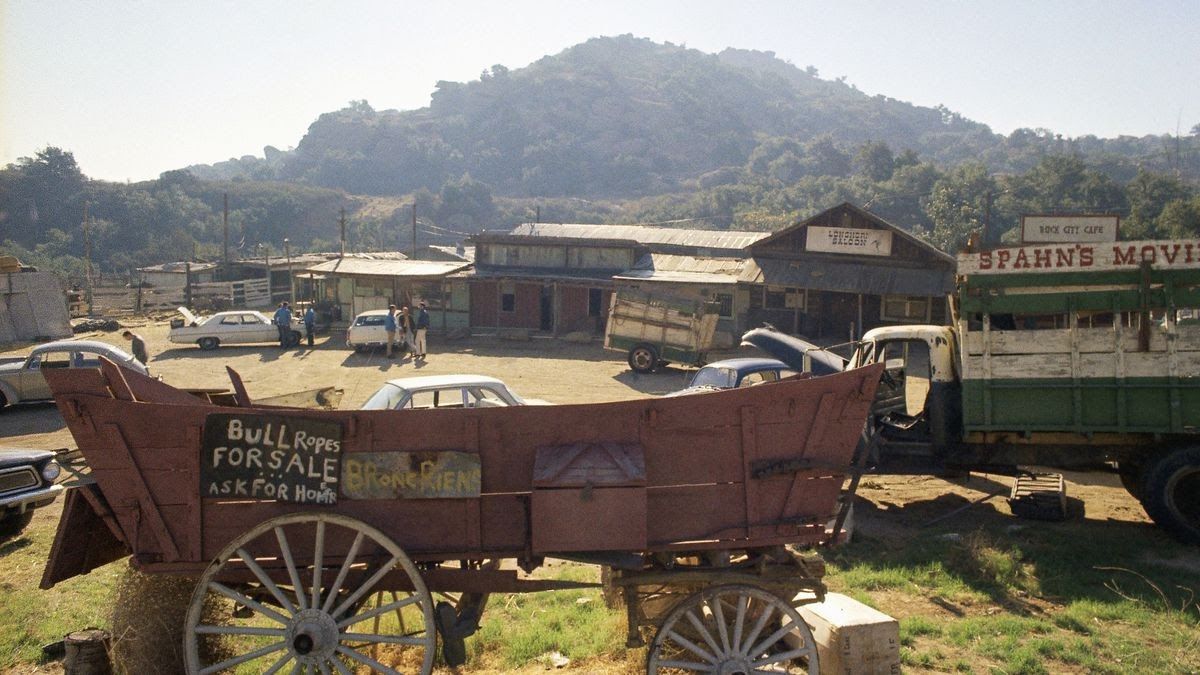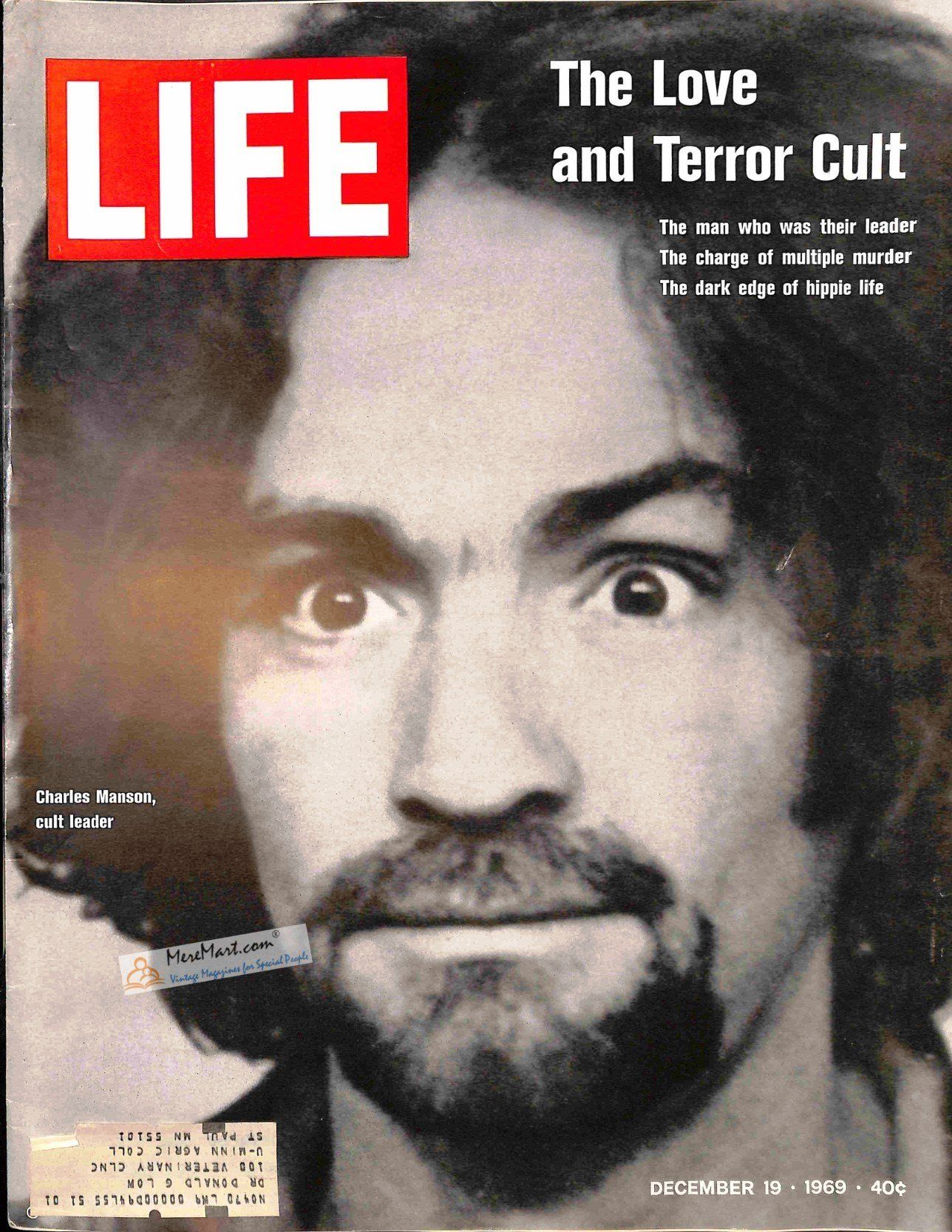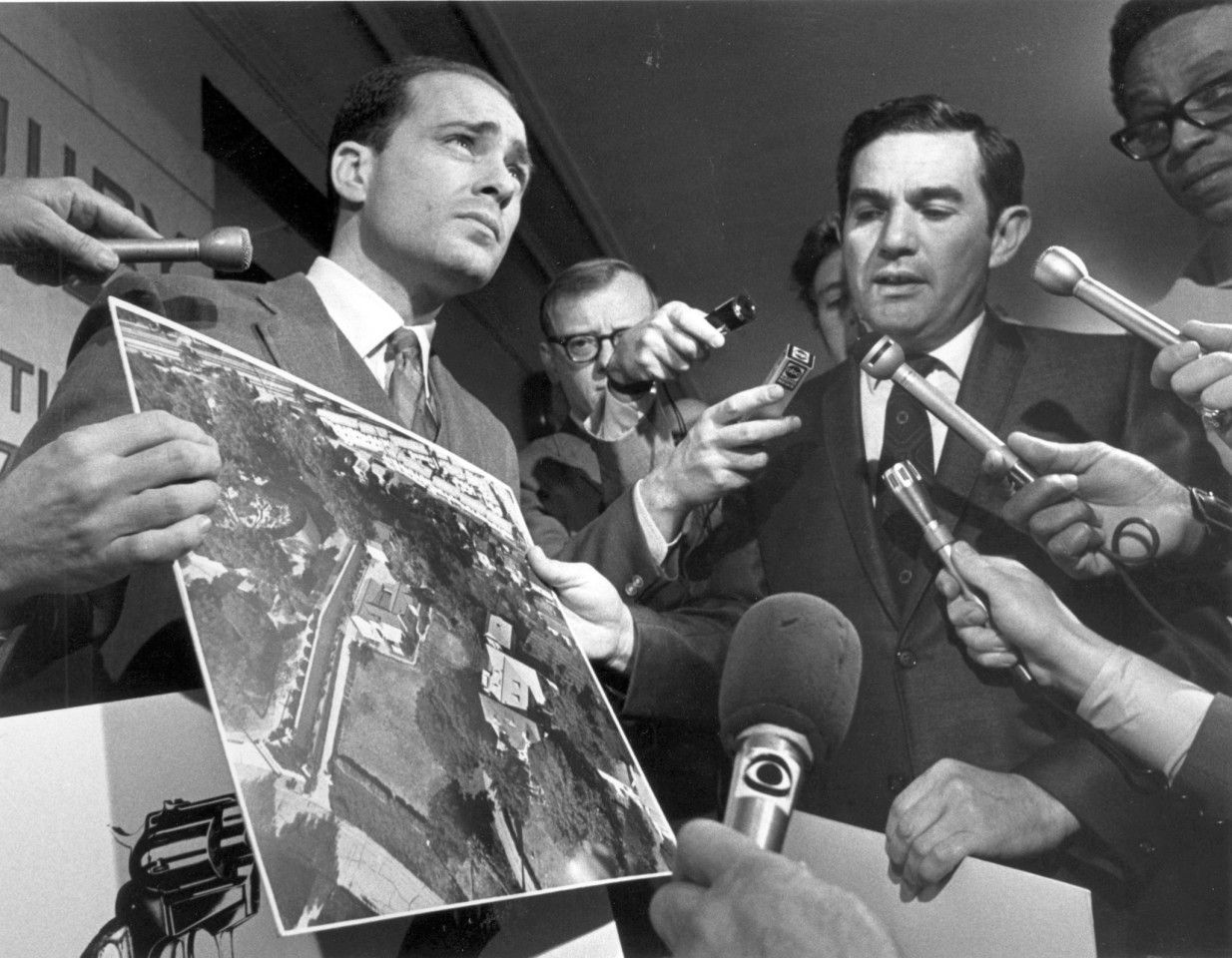
Cease to Exist
Fifty Years Ago, The Manson Family Was Sent To Death Row. Part I In A Series About The Mysteries Which Remain.
About forty miles northwest of the Hollywood sign, buried under a thicket of pricker bushes and poison oak in the Santa Susana Pass, lies whatever remains of the Spahn Movie Ranch. Nobody ever redeveloped the land. Here in the northwest corner of Los Angeles County, the farthest you can get while remaining in the city, the only recent additions had been a guardrail on the road, running the length of where Spahn Ranch once stood, and the construction of a clean, bright church on the opposite hilltop.
Standing there today, before those sandstone hilltops littered with big boulders, the backdrop of all those “Bonanza” episodes they’d filmed there, the valley has only grown more desolate - astounding, given that the march of decades in Los Angeles has destroyed virtually everything else from back then. It is hard to imagine how this valley could have been even more dark and quiet fifty years earlier, July 27th, 1969, when Mary Brunner and Susan Atkins drove here in the stolen car of Gary Hinman, who they had just helped stab to death in Topanga Canyon.
The slaying of Hinman, a gentle musician and part-time mescaline dealer who had been tortured for three days, would be the first murder definitively linked to Charles Manson and his “Family.” By the time of Manson’s final arrest in December 1969, at least eight more people would be dead at the hands of his followers, killed in the worst ways eight people can be killed. In the same summer mankind first walked on the moon, it was the savagery inflicted upon these victims–and most particularly, upon eight-and-a-half month pregnant actress Sharon Tate, slain begging for the life of her unborn son–that seemed inescapable even in orbit.
In talking to people alive to remember the events of August 1969 as they occurred, I was struck by how palpable the fear and sense of disturbance still was. The nightmare of crazed, acid-eating hippies, daubing the walls of Los Angeles with blood-inked messages, is eclipsed only by the unsettling mugshot gaze of their mad hippie king. Staring out from the front page of every newspaper, eyes fiery and wide, Charles Manson, whose insane edicts might someday hasten an apocalyptic race war, was instantly emblematic of the counterculture, particularly for all those who had loathed what was happening in America in the 1960s.

Starting the morning of August 9th, 1969, the murders had exploded from morning newspapers and evening newscasts across America, instantly ubiquitous as “senseless” and “savage” and “gruesome.” The presumed motive–that the Tate house at 10050 Cielo Drive had been targeted to terrorize the previous tenant, music producer Terry Melcher, for never signing Manson to a record deal–made what was already a celebrity story that much more perverse. That the victims were a budding Hollywood starlet, a celebrity hairdresser, a coffee heiress, a Polish screenwriter, and a stolid suburban couple, all massacred in home invasions, made the crimes seem like they had been invented not just to terrify, but to captivate an anxious Middle America.
And which still captivates, perhaps. Fifty years on, “We may be stuck with Charlie Manson for a while,” wrote journalist Ed Sanders last year in the New York Times. Sanders knows of what he speaks. As a columnist for the alternative Los Angeles Free Press, Sanders immediately began reporting on this alleged murder commune given to dumpster diving and Beatles music, ultimately producing The Family in 1971, the first book released about the Manson cult. But while Sanders's book remains one of the best, its cultural influence pales in comparison to another account.
Chief among all accounts of the Manson Family–and indeed, occupying a lofty position among all non-fiction books produced in the twentieth century about any subject–is Helter Skelter, the number one bestselling true crime book of all time. Co-written by the lead prosecutor at the Manson murder trial, Vincent Bugliosi, the book is the rare blockbuster memoir that is also exceedingly well-written and engrossing. If you know any details about the Manson Family, it probably originated in this book, which cemented Bugliosi's star status as an author and legal commentator, right up until his death in 2015.

For many, the case was proof that the ultimate destination of the counterculture was murder–ultraviolence so savage it was enough to slam the door shut on whatever idealism had been supposedly proffered in the years prior. If one feels a covert relief in hearing Joan Didion claim, in her 1979 essay “The White Album,” that the Sixties “ended abruptly on August 9, 1969, ended at the exact moment when word of the murders on Cielo Drive traveled like brushfire through the community,” they are hardly alone.
Of course, by the time Didion wrote of how “the tension broke that day [and] the paranoia was fulfilled,” Manson, the Svengali of Chatsworth, had been caught, tried, and convicted for the murder spree–along with killers Charles "Tex" Watson, Leslie Van Houten, Patricia Krenwinkle, Bruce Davis, Steve "Clem" Grogan, and Susan Atkins. Saved from the gas chamber only by its abolition in California, Manson would recur in pop culture mostly to yell at Diane Sawyer or Geraldo Rivera in a series of truly pointless jailhouse interviews, which nevertheless always drew high ratings, prior to his own death in 2017.
With most of these Manson cultists still alive and in California prisons–among the longest-imprisoned inmates in America–there was no mystery left unsolved; the whodunit was a theydunit, the particulars ossified in time, inside a trillion layers of repetition. The story of the Manson Family has been generally accepted as a Sixties cautionary tale, its morals to be repeated forever.
Like chaparral reclaiming Spahn Ranch, from which so much bloodshed had been launched, so too has time trampled underfoot the story of the Manson Family. The received wisdom about Manson and his wickedness inform an entire regime of cultural memories.
Even as the past comes roaring back, exploding into the present and threatening to destroy our basic understanding of what happened in 1969.
What if the foundation of our understanding of these crimes is false?
What then, if, as one classic of Sunset Strip psychedelia suggests, forever changes?
The fiftieth anniversary of the Manson Family slayings prompted a welter of news stories, articles, and essays looking back at the crimes, and ubiquitous amongst nearly all of them was the same phrase: “the death of the Sixties." The most famous iteration and influential rendition of this idea came from writer Joan Didion, in the aforementioned title essay of her 1979 collection The White Album. In the famous opening, Didion opines that “We tell ourselves stories in order to live,” imposing “a narrative line upon disparate images” so as to adduce some clear moral or lesson from our experiences. In Didion’s recollection of the Sixties, memory may be kaleidoscopic, and events cannot be put in a linear order. But what is clear for Didion is that the gruesome violence of the Tate-LaBianca tragedy was the ultimate finishing point of the decade, the wages of a strange, unhinged time.
Didion’s recounting of the era centers upon the Manson slayings as the grim culmination of all that messy campus activism, dissolute rock musicians, black nationalism, and strange new communes popping up like dandelions. Indeed, in Didion’s telling, “no one was surprised” that five people had been slaughtered in Roman Polanski’s Benedict Canyon mansion - a curious note to strike about a crime which still has the capacity to shock.
The implication–that the most nightmarish violence imaginable was inevitable outcome of all this Sixties Californian lunacy–has powerfully informed the larger mainstream consensus around the Manson Family ever since. Charles Manson’s elevation as the dark avatar of the Sixties–the Antichrist come to Los Angeles–endures today in America’s cultural memory, the ultimate boogeyman to warn against the freak lifestyle of his time and place. But this interpretation of the crimes doesn’t merely do a great disservice to the victims, meanly minimizing their suffering as the wages of some epochal lesson.
The conflation of the Manson Family with the wider cultural revolutions of the era is a highly pernicious and dubious proposition, serving a largely reactionary interpretation of the crimes. Such a view not only does little to advance a meaningful understanding of the crimes. This perspective validates a widespread hostility, then and now, toward the counterculture, while personalizing structural inequities as the exclusive property of one cracked, nightmarish guru.
This transformation of Charles Manson, a barely literate career criminal, into the malevolent force responsible for ending the era, rests on a curious contradiction. In this version of events, Manson is a uniquely evil force whose exploitation of the counterculture’s naivete ultimately destroyed a time of peaceful idealism and brotherly love. This conviction persists to this day, as exemplified most recently in Quentin Tarantino’s “Once Upon a Time in Hollywood,” which casts the killings as bringing a pall over an era of light-hearted innocence.
But this raises a curious question: what innocence and idealism, exactly, did the Tate-LaBianca murders wreck? Even the most cursory examination of the Sixties reveals quite a different reality, than the apparent void into which the murders clanged: the decade was incredibly, unceasingly violent. For an essay purportedly about the Sixties, Didion’s “The White Album" contains no mention of the most murderous Californian of the time, Richard Nixon. There is no mention of the Vietnam War, and the wider savagery visited upon Southeast Asia; the campus activists of the era are engaged in “industrious self-delusion,” faintly ridiculous dead-enders whose motives are not explored in the slightest.
Race riots, horrific carpet-bombing, the assassinations of Malcolm X and Martin Luther King and the Kennedys–these were only the most famous examples of the violence wracking America at the time. Far more rote brutality coursed through the country at the time, almost entirely originating not from the panoply of militant activists associated with the Sixties, but from the mainstream, from the institutions, from the police and military and Congress and statehouses, all in the name of law and order. Police and security service action against the counterculture was endemic; from spying, to dirty tricks, to assaults on activists like Abbie Hoffman, such efforts involved prominent, powerful hard-rightists, all the way to the Oval Office.
There were even darker conspiracies afoot. As revealed in journalist Tom O’Neill’s recent book on the Manson story, Chaos, in January 1969, FBI COINTELPRO agents had successfully engineered the murders of two Black Panthers on the UCLA campus, using informants to prod a rival black nationalist group into the crimes. In May 1969, Ronald Reagan, then Governor of California, ordered the California Highway Patrol into UC Berkeley, where they shotgunned dozens of students, killing one and blinding another. And in December 1969, Black Panther leaders Mark Clark and Fred Hampton were murdered in a Chicago police raid, under circumstances which strongly suggested clear extrajudicial murder.
By placing the Manson Family as the fulcrum of the era’s tipping point, when some hazy, tie-dyed memory of good vibes was drenched with blood, writers such as Didion don’t merely depoliticize the era; they quite sharply recast history in a way that sanitizes the events. Violence becomes the provenance of the losers, the history conveniently confirming all of the cultural beliefs a stalwart Goldwater voter like Joan Didion might have espoused, however eloquently.
Joan Didion is blaming the losers of the Sixties, so smugly, that entire generations of readers have not seemed to notice they are endorsing the views of a fussier, more stylish Pat Buchanan. There has to be a better answer. And I suspect it has some relevance for our current state of affairs.
If the popular understanding of the Manson Family has often been a cynical one, deployed selectively to sully the Sixties counterculture as inherently sinister, it begs the question: what can we learn from the tragedy? And what is the best way of understanding the seemingly incomprehensible events of August 1969?
The answers feel especially relevant and timely now. Manson prosecutor Vincent Bugliosi’s description of Manson as a “right-wing hippie” seems largely accurate. Manson, a grifting former pimp, had no political ethos beyond perhaps his white supremacism, a streak which only grew more prevalent following his final incarceration. Indeed, the entire hippie phenomenon of 1969 was hardly as political as popular memory leads us to believe. As reported in Hunter S. Thompson’s 1967 essay on San Francisco’s Haight-Ashbury, hippies were not the student activists who had roiled campuses around the country in the years before; they were apolitical waifs, running away from the heaviness of activism and in search of some cultural anodyne.
Manson once called himself “The Gardener,” a nickname he claimed came from collecting flower children. It was an unfortunately apt description. Manson’s predation upon girls, largely teenage and as much as fifteen years younger than himself, was perhaps more definitive a feature of his cult than the savage violence for which it became forever known. It was a pattern of abuse in which Manson exploited the psychological vulnerabilities of extremely young women, already alienated from their middle-class families of origin, and “love bombed” them, grooming them as special, valued, and unique.
Reading the accounts of Manson’s manipulation, one does not find his methods of domination so inexplicable, the brainwashing of a mysterious Svengali, gifted with strange powers of mind control. Actually, Manson’s methods are quite banal, and common to domestic abusers - alternating between threats and inducements, with his female victims isolated on remote ranches, separated from any external influences, not even able to own wristwatches.
Even more heartbreaking is that the impulses Manson exploited, to such disastrous effect, were quite common to women of the era. “I seemed to want more out of life,” recounted convicted Manson Family killer Leslie Van Houten in a 1993 prison interview, “than what was expected of young girls at that time. Drugs, sex. Y’know, breaking away from the norm.” Van Houten was hardly alone among young girls of her generation in seeking this out - and less remarked upon than the nightmares of the Family was the large-scale, and often serene, migration of many young women to communal living, raising children on estates like the Hog Farm away from mainstream society.
But Van Houten helped stab Rosemary LaBianca to death; most young women of the time never did anything remotely similar. The antisocial annihilation the Manson cult ultimately embarked upon lives with us today as singularly horrific. But there is room for a new perspective on the crimes which dispenses with the cynical politicizing of the crimes as the invariable product of any alternative ways of life. Indeed, the greed, racism, and fame-seeking which defined and animated Manson are hardly unknown to American life, and it is the misogyny of the crimes - embodied most awfully with the death of pregnant Sharon Tate’s eight-and-a-half month old baby - which seems most striking now.
If anything, the true horror might be that this most freakish crime did not originate from the fringes of society; it was a frightening reflection of mainstream American desires, in the cracked glass of one struggling songwriter. We have a duty to not forget this, no matter how comforting it would be to consign such beasts to the shadows; the killer, to echo the famous short story, was calling from inside the house.
So what's the real story?
